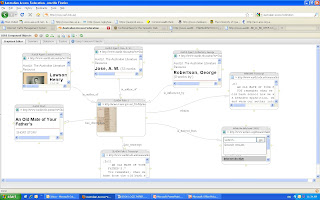 With an increasing amount of images and full-text being digitised and delivered by local, national and international institutions, the need to be able to bookmark, relate and describe these resources is becoming more and more necessary. The Aus-e-Lit Project aims to assist researchers by developing tools that extend the specifications and protocols delivered by the Open Archives Initiative, specifically specifications relating to Object Re-use and Exchange. For researchers in the field of Australian literary and print culture studies, Aus-e-Lit tools developed from these principles will allow them to gather text, image, video and audio files in their Firefox browser window and realate them to specific fields in an AustLit Record. I'll run through a few examples to demonstrate what I mean.
With an increasing amount of images and full-text being digitised and delivered by local, national and international institutions, the need to be able to bookmark, relate and describe these resources is becoming more and more necessary. The Aus-e-Lit Project aims to assist researchers by developing tools that extend the specifications and protocols delivered by the Open Archives Initiative, specifically specifications relating to Object Re-use and Exchange. For researchers in the field of Australian literary and print culture studies, Aus-e-Lit tools developed from these principles will allow them to gather text, image, video and audio files in their Firefox browser window and realate them to specific fields in an AustLit Record. I'll run through a few examples to demonstrate what I mean.If you're unfamiliar with the Aus-e-Lit Project, follow the link provided for a full description of the project's aims, a number of technical articles, and a few video demonstrations of the tools in action. As the interface is constantly changing, new videos will be produced later in 2010, but, for now, these give a good idea of the basic functions of compound objects and the associated annotation tool.
LORE (Literature Object Re-use and Exchange) is the name given to the software that has been developed as an extension to the Firefox browser. A small file can be easily installed in the Firefox "Add-ons" found in the Tools menu of the browser. Once this is done, you are free to bookmark and describe internet resources in as little detail or as much detail as you want. The screen-shot at the top of this posting is a collection of resources (AustLit records, text files and images) available on the internet. These resources have been bookmarked and the user has begun to create relationships between the reources and add metadata to describe each resource in order to gather as much information as they can for future reflection or for sharing with peers.

By adding metadata derived from Dublin Core standards to specified fields, the collection of resources and the relationships between them become more meaningful. Ultimately, users will have the ability to choose whether they want to share this information with others, but the potential for collaborative research on a large scale is very significant.
One of the most obvious examples is the creation of social networks around particular periods or cultural groups. At the moment AustLit records limited relationships between people (primarily "is influenced by"), but networks of influence could be created by relating the AustLit records of individuals associated, say, with the Bulletin in the 1890s. The variety of relationships that A.G.Stephens had with writers, publishers, artists could be clearly defined to visualise the networks of influence that determined who was published or reviewed and why. Is it just literary, or are their other factors determined by the various relationships between people. Such an activity could be done collaboratively by small, large and mass groups of contributors, building networks of influence that might begin with A. G. Stephens but merge with other editors, publishers, critics and writers. In collaboration, a better understanding of the print culture networks would emerge quickly, potentially revealing clusters of influence that have escaped notice.
Several important contributors to the development of Aus-e-Lit tools will sit on a panel at the annual conference of ASAL, 8-10 July 2010. Over the next few months their experiments will be featured here to demonstrate what is possible as far as the discovery, organisation, description and communication of related internet resources is concerned. Textual transmission, adapatation, artist-poet collaborations, and collaborative interpretation will be some of the themes covered. Please leave a comment if you'd like to join the conversation or visit us at ASAL.




No comments:
Post a Comment
We Welcome Your Comments and Feedback